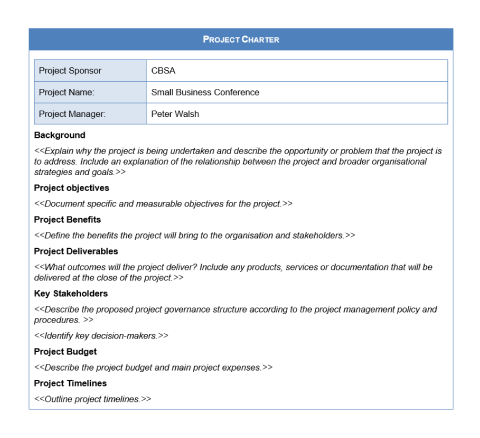In this chapter, you will learn the skills and knowledge required to manage a project plan by looking at how to integrate the project effectively.
By the end of this topic, you will understand:
- Business impact analysis
- Project integration management
In this section, we will discuss Business Impact Analysis and what to consider while analysing, together with its five phases.
A Business Impact Analysis (BIA) is a risk management process that studies and identifies areas that may be impacted by a major disruption.
A BIA defines the following elements:
- It forecasts any financial loss that may be incurred as a result
- It outlines a strategy and a plan of action for if or when something goes wrong
- It outlines potential disruptions or risks, including recovery and continuity strategies
- It anticipates both expected and unexpected hurdles.
BIA Contents
Your BIA should consider the project life cycle. Project managers should check off each of the following categories in their business and project impact analyses:
- Products, services, and recurring projects offered by your organisation
- The implicit and explicit costs of failing to deliver on any of these areas
- An assessment of the costs and availability of tools and supplies used to accomplish these tasks
- A list of procedural and financial priorities to reference during potential setbacks
- A continuity plan that details the minimum requirements needed to remain operational during any disruptive event.
Reference: Maria, 2020
Learn about the elements of BIA by reading the article What Are the 5 Elements of a Business Impact Analysis by Chron.
“There isn’t one single method for performing a Business Impact Analysis.” Jing Cong, 2019
There isn’t one single method for performing a Business Impact Analysis.
Jing Cong, 2019
Phases of Business Impact Analysis (BIA)
The phases of BIA are an extension of the fourth element, the Business Impact Analysis Process. Each organisation will need to customise the process for its unique needs. However, a few phases of a Business Impact Analysis need to be present for it to be successful; we take a look at these phases below.
Five Phases of Business Impact Analysis
-
Preparation
As part of the preparation:
- Understand who will be part of your project team to complete the work
- Define the goals and objectives you will assess through your impact analysis in consultation with upper management.

-
Information Gathering
Phase 2 requires you to gather raw data about your business processes.
The most common methods of obtaining this data are interviews with the people in charge of each function, along with a company impact analysis questionnaire. Once all surveys have been collected, or interviews have been completed, it's time to combine the data for each process into one document.

-
Information Review and Analysis
Once you have collected all the information needed for each business process, you are ready to review and analyse the information.
The Business Impact Analysis team will look at each process to determine:
- Which functions and processes are most important to your business’ continual operation?
- What roles and technology are required for each process?
- What is the recovery time needed to bring the process back to normal operation?

-
Business Impact Analysis Report Creation
Once all this information has been analysed and confirmed, you’ll prepare a Business Impact Analysis Report to present to senior management and other stakeholders in disaster recovery.
The Business Impact Analysis report will include the following information:
- Executive summary
- Objectives and scope
- Methodology used to collect information
- Findings about processes, functions, disruptions, risks, acceptable risks, potential costs and recovery strategies
- Supporting documents
- Recommendations for recovery.

-
Business Impact Analysis Recommendation Implementation
The final step in this process is implementing recommendations.
Once your team has conducted the Business Impact Analysis and communicated the findings, it is ultimately up to leadership to act on the recommendations. Your team can help promote the findings of the analysis and encourage leadership to move forward with your advice.

In this section, we will introduce Project Integration Management and discuss its importance and key processes.
Project integration management is the coordination of all parts of a project:
- Assesses the situation so decisions can be made
- Ensures project management is integrated and not managed in isolation
- Considers how project components relate to each other and other parts of the organisation
Importance of Project Integration Management
Projects are complex, with many different parts that need to be managed. For example, a project manager must oversee all the items listed below.
- Schedule
- Cost
- Quality
- Resources
- Risks
- Changes
- Stakeholders
- Scope
Keeping track of everything and knowing how one impacts others can be challenging. Therefore, project integration management is essential!
The following scenarios are a few examples to express its importance further:
| Scenario 1 | A decision about your project can impact other projects and other areas of the business |
| Scenario 2 | Decisions about a scope change can impact your schedule, costs, and resource requirements |
| Scenario 3 | It is difficult to identify conflicts in advance and how to resolve them. |
Key processes of Project Integration Management
In this final section, we explore the seven key processes involved in successful project integration management.
- Establish a project charter
- Develop a preliminary project scope statement
- Develop a project management plan
- Direct and manage project execution
- Monitor and control project work
- Integrate change control
- Close project
Let us now explore each key process in detail.
-
Establish a project charter
A Project charter:
- is an official document that describes the project and objectives
- outlines how the work will be performed
- defines the stakeholders
- is used during the project lifecycle.
A Project Charter document will typically have the following format:
Background Project Objectives This section explains why the project is being undertaken and describes the opportunity or problem that the project is to address.
The background outlines how the project fits into and connects with the organisation’s strategic goals.
This section documents specific and measurable objectives for the project. Here is a template that can be used to develop a Project Charter.

-
Develop a preliminary project scope statement
To minimise the risk of scope creep, you must develop a project scope statement. The project scope statement provides a high-level definition of the project scope. This document highlights the project management methodologies and tactics to be used in the project.
We describe a scope creep below.
Scope creep is a dreaded thing that can happen on any project, wasting money, decreasing satisfaction, and causing the expected project value not to be met.
Project Management Institution
A Preliminary Project Scope Document will typically have the following format:
Project scope This section describes what the end results of the project will be, such as the project outcomes.It includes a brief description of workplace impacts. Key stakeholders This section describes the proposed project governance structure according to the project management policy and procedures. Project budget This section describes the main project expenses. Project timeline This section outlines project timelines. Constraints This section describes key project constraints. Assumptions This section describes the key project assumptions. Dependencies This section describes any project dependencies. Preliminary risk assessment This section identifies any foreseen risks with the project. -
Develop a project management plan
A project management plan is an essential tool for any successful business undertaking. It is a document that outlines the scope and execution of a particular project and provides direction for everyone involved in the process. The plan outlines the goals, resources, timeline and budget required to complete the project successfully.
The primary goal of a project management plan is to ensure that all stakeholders understand their roles and responsibilities in the completion of the project. By providing this clarity at the beginning, it removes guesswork from later stages and increases efficiency among those working on it. This makes sure deadlines are met and costs remain within budget while still delivering successful results.
Organisations can customize their own plans with specific details such as team members' names, responsibilities, delegated tasks or risk mitigation strategies needed to complete a project successfully.
Create a project management plan to define how the various processes in the project can work together for greater efficiency and productivity.
The Project Manager creates the project management plan, which may include links to other organisational plans such as:
- Scope management plan
- Cost management plan
- Quality management plan
- Process improvement plan
- Human resource plan
- Communication management plan
- Procurement management plan
A project management plan will typically have the following layout:
Title Start with the project title Background or context This will be as per the project charter Objectives This will be as per the project charter Target outcomes This will be as per the project charter Success measurement This section will show how the success of the project will be measured. The response may include the following:
- Project completed to time and budget specifications
- Increase sales by 20% during the first year
Project activities and milestones This consists of the Work Breakdown Structure (WBS) information that we learnt in topic 1 Project budget This section will show the total project budget Project communications Below is a sample table structure for project communications
Communication type Description Schedule start date Schedule end date Meetings Meetings between the project management and the project team member will take place as listed below:
- Project establishment meeting
- Weekly meetings during the life of the project
- Project review meeting
DD/MM/YY DD/MM/YY Risk management strategy Illustrated below is a sample table structure of a risk management strategy.
Risk Likelihood Severity Treatment or control methods Staff members on leave Occasional Significant Use an existing staff member to assist with the project Budget overrun Occasional Moderate Record project costs each week to check where the budget is overrun. Delay in completion Probable Catastrophic Seek assistance from additional staff and schedule project meetings to check progress. Monitoring and control of project As discussed in this topic, a number of methods will be used to monitor and control the project. Listed below are some examples.
- Weekly project status report indicating activities during the week and progress against agreed timeframes.
- Weekly project meetings to discuss website content and provide feedback to the developer.
- The project manager will engage weekly with the website developer to discuss progress and provide feedback.
-
Direct and manage project execution
In this process, Project Managers will implement project activities and their execution.
Project managers must ensure that everything happens in light of the project plan and scope statement.
-
Direct and manage project execution
As discussed above, this includes measuring and balancing the project’s progress and being proactive in taking corrective measures to eliminate any issue that can threaten your project’s success chances.
This process focuses on meeting project objectives and manages all the obstacles that are disrupting your project from achieving its goals.
-
Integrate change control
By implementing change controls, Project Managers can easily calculate, approve, and direct changes smoothly. As a result, only verified changes will be implemented, enabling you to achieve higher client satisfaction to drive your project to success.

-
Close project
When you have completed all project activities, delivered the final project to the clients, and received the client’s approval, it is time to close the project.

